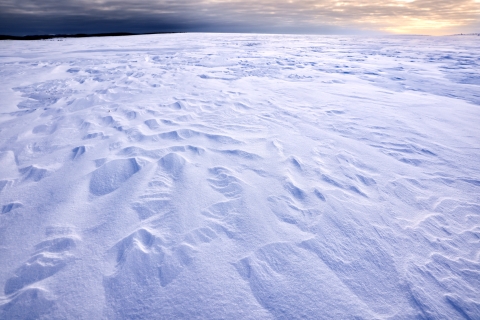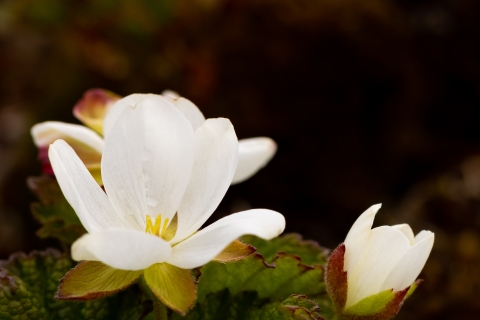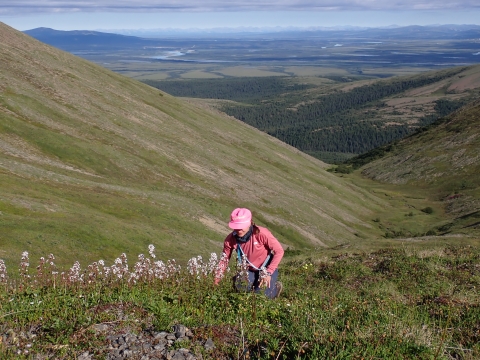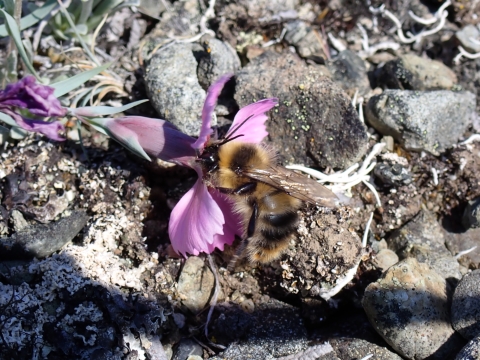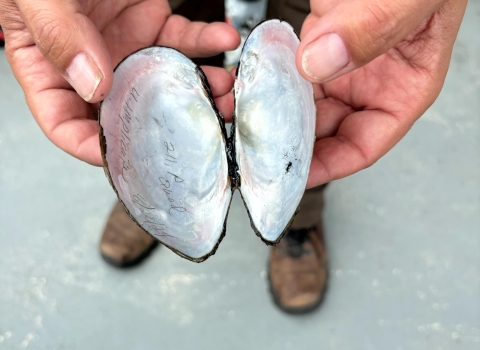Beneath the frozen tundra of Selawik National Wildlife Refuge, a love story waits to bloom...
This far north, Valentine's Day is often a frosty celebration. Temperatures can plummet more than 40 degrees below zero and the icy wind scours snow across the tundra.
Yet nestled beneath the surface of a frozen meadow, a queen sleeps in deep winter hibernation. Her delicate wings fold against a body covered in thick black and gold fuzz. In a few months, the sun will wake her, and she'll create a seasonal army of devoted followers.
The meadow around her also sleeps, waiting for the summer love affair that begins with the thaw of the rare Bombus frigidus, Arctic Alaska’s frigid bumble bee.
Hot to go and built for love in the cold
These insect champions are tough survivors adapted to the extreme conditions of high latitudes and elevations. Found primarily in the boreal forests, tundra, and subalpine regions of Alaska and Canada, frigid bumble bees keep things running hot with an entire suite of adaptations.
Their long, thick "fur coat" of body hair helps maintain warmth. Their larger size—they're among the biggest of Alaska's native bee species—allows better heat conservation in temperatures that would ground their smaller cousins. Like tiny space heaters with wings, frigid bees can even generate heat on demand by shivering their flight muscles, warming both themselves and their colony.
When it comes to courtship, frigid bumble bees don’t hold back. While some bee species spend up to 80 minutes in mating rituals, Bombus frigidus takes more of a speed dating approach, with rendezvous lasting around ten minutes.
Friends with benefits: the bee and the bluebell
Relationship status? It's complicated.
Summer moves fast in the Arctic, and flowering plants have evolved to make the most of their brief moment in the spotlight. The northern bluebell (Mertensia paniculata) is involved in an intricate partnership with the frigid bumble bee that benefits both species: a relationship strategy known as ‘mutualism.’
This relationship hinges around the bees’ unique color vision. Bumble bees perceive the world through blue, green, and ultraviolet light rather than our human spectrum of red, blue, and green receptors.
The bluebell takes advantage of this by staging a color-changing display: young flowers bloom pink and produce only pollen, while mature flowers turn blue and offer sweet nectar. A single plant stalk presents this mixed visual bouquet, using blue to catch the bee's beautiful compound eyes while ensuring both stages of flowers receive vital visits. The bee benefits by gathering their favorite sweet treats (you know, nectar and pollen), and in return the plants benefit when their fuzzy buzzing buddies make sure flowers are fertilized.
Many other Arctic flowering plants also depend on Bombus frigidus and friends to flourish and reproduce, including willow species and wild tundra berries like the aqpik (salmonberry; Rubus chamaemorus).
Are you pollinator-curious?
Just as northern peoples have long relied on cooperation, Bombus frigidus and Mertensia paniculata have survived in extreme conditions for generations through their clever adaptations and partnerships.
At Selawik National Wildlife Refuge and across Alaska's 16 national wildlife refuges, scientists and community members are working to document wild bee distribution as part of a larger statewide effort. Through the Alaska Bee Atlas project, a multi-year collaborative effort led by the University of Alaska, volunteers carry out bee sampling using a consistent method. Experts in insect identification then carefully determine the bee species collected during the surveys. Together, contributors are building a more complete understanding of pollinators in the north and their importance to wildlife, landscapes, and people.
Bombus frigidus first turned up in Selawik Refuge’s samples in 2022 and was found again in 2024 along the Tagraġvik (Tagagawik) River. In total, 214 specimens of the frigid bumblebee have been recorded in the Alaska Bee Atlas so far, from the Aleutian Islands to Venetie and the Kanuti River to Prince William Sound.
Want to join the effort? Visit https://accs.uaa.alaska.edu/wildlife/ak-bee-atlas/ to learn more and become an admirer - or even a volunteer.
More than a fan... we’re involved
We’re all involved in the love story of pollinators and plants. Whether you find joy in summer wildflowers or delight in harvesting Alaska’s wild berries, take a moment to appreciate the many ways that Bombus frigidus and its pollinator friends nourish our lives.
Their story reminds us that even in the coldest corners of Alaska, life finds a way to thrive through teamwork and adaptation—perhaps the ultimate Valentine's Day message from the natural world.


